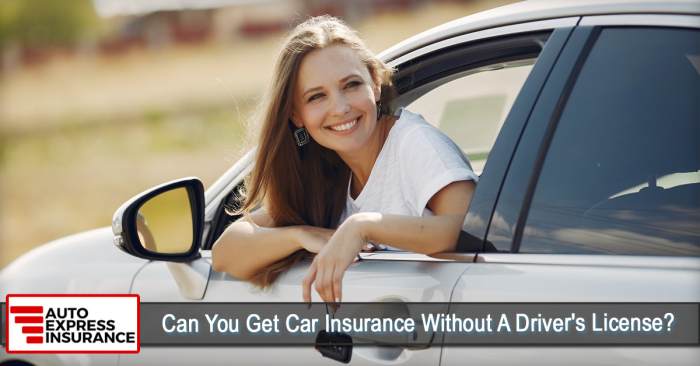The question, “Can I get car insurance without a car?” often arises for individuals who don’t own a vehicle but still need coverage. This surprisingly common scenario encompasses a range of situations, from frequent renters to those who occasionally borrow cars. Understanding the nuances of non-owner car insurance is crucial for protecting yourself from liability and financial burdens in unforeseen circumstances. This guide will explore the various types of insurance available, the application process, and the crucial aspects of coverage and exclusions.
Many believe car insurance is solely for car owners, but this is a misconception. Several insurance options cater to individuals who don’t own a car but still face potential risks while driving. This guide will demystify the process, helping you understand the available options, their costs, and how they protect you in various situations, from renting a vehicle to driving a friend’s car.
The Application and Quoting Process

Securing car insurance without currently owning a vehicle is entirely possible, primarily for situations like planning a future purchase or needing liability coverage for driving other people’s cars. The application process itself is fairly straightforward, although the specific requirements and information requested may vary between insurance providers.
The application process typically involves providing personal details and information related to your driving history and the intended use of the insurance. This allows insurers to assess risk and provide an accurate quote.
Information Requested During the Application Process
Insurers will request a range of information to understand your risk profile. This usually includes your full name, address, date of birth, driver’s license number, and Social Security number. They will also inquire about your driving history, including any accidents, traffic violations, or suspensions. Furthermore, you’ll be asked about your intended use of the vehicle you plan to insure (e.g., commuting, pleasure driving), the type of vehicle (make, model, year), and the anticipated mileage. Some companies may also ask about your credit history, as this can be a factor in determining your premiums. Finally, you’ll need to provide contact information, such as your phone number and email address.
Factors Influencing Insurance Quotes
Several factors influence the cost of car insurance, even when you don’t yet own a car. Your driving record is paramount; a clean record will result in lower premiums compared to someone with multiple accidents or violations. Your age and location also play a significant role, as younger drivers and those living in high-risk areas generally pay more. Credit history can also be a factor, with good credit often leading to lower rates. The type of coverage you choose (liability only, comprehensive, collision) directly impacts the cost, with more comprehensive coverage naturally being more expensive. Finally, the type of vehicle you intend to insure will influence the quote; insuring a high-performance sports car will be more expensive than insuring a smaller, economical vehicle. For example, a young driver with a poor driving record living in a large city will likely receive a higher quote than an older driver with a clean record living in a rural area and insuring a less expensive car.
Obtaining Quotes from Different Insurance Providers
A step-by-step guide to obtaining quotes is as follows:
1. Gather your information: Compile all the necessary personal and driving information mentioned above.
2. Visit insurer websites: Many insurers allow you to get instant quotes online by completing a short form. This is often the quickest and most convenient method.
3. Contact insurers directly: You can also contact insurers via phone or email to request a quote. This allows for more personalized assistance, particularly if you have complex circumstances.
4. Compare quotes: Once you’ve received quotes from several insurers, compare them carefully, paying attention to the coverage offered and the premium cost.
5. Choose a policy: Select the policy that best suits your needs and budget. Remember to read the policy documents thoroughly before agreeing to the terms.
Coverage and Exclusions

Car insurance policies for individuals without a car, often called “non-owner” policies, provide liability coverage, protecting you financially if you cause an accident while driving someone else’s vehicle. These policies generally don’t cover damage to the car you’re driving; that’s the responsibility of the car owner’s insurance. Understanding the specific coverage and limitations is crucial before purchasing a policy.
Coverage offered under a non-owner car insurance policy typically includes bodily injury liability and property damage liability. Bodily injury liability covers medical expenses and other damages resulting from injuries you cause to others in an accident. Property damage liability covers the cost of repairing or replacing the property of others that you damage in an accident. Some insurers may offer optional Uninsured/Underinsured Motorist coverage, protecting you if you’re injured by an uninsured or underinsured driver. Medical payments coverage, which helps pay for your medical bills regardless of fault, might also be available as an add-on. However, comprehensive and collision coverage, which typically covers damage to your own vehicle, is not included in a non-owner policy because you do not own a vehicle.
Types of Coverage Included
Non-owner car insurance policies primarily focus on liability coverage. This means they protect you against financial responsibility for injuries or damages you cause to others while driving a borrowed or rented car. The specific limits of liability coverage (e.g., $25,000/$50,000/$10,000 for bodily injury and property damage) are chosen by the policyholder and vary depending on the insurer and the state’s minimum requirements. It’s important to choose liability limits that reflect your potential financial exposure. For example, higher limits provide greater protection if you are involved in a serious accident.
Potential Exclusions and Limitations
Several exclusions and limitations commonly apply to non-owner car insurance policies. For example, coverage may be excluded for accidents involving vehicles you own, even temporarily. The policy might not cover accidents occurring outside of your designated geographic area, or while driving a vehicle specifically excluded in the policy’s terms. The policy may also have limitations on the types of vehicles you’re covered to drive; some policies may exclude certain commercial vehicles or those used for specific purposes. Furthermore, the coverage might not apply if you are driving under the influence of alcohol or drugs. Always review your policy carefully to understand its specific limitations.
Circumstances Leading to Claim Denials
Claims under a non-owner policy might be denied for various reasons, including driving a vehicle not specified in the policy, driving without a valid driver’s license, operating a vehicle while under the influence of alcohol or drugs, or failing to cooperate with the insurer’s investigation of the accident. Providing false information during the claims process can also result in a claim denial. Additionally, if the accident occurred in a location specifically excluded in your policy, the claim could be rejected. It’s crucial to comply with all policy terms and cooperate fully with the insurer to ensure a smooth claims process.
Coverage Comparison Across Providers
Different insurance providers offer varying coverage options and pricing for non-owner car insurance. While the core coverage (liability) remains consistent, the specific limits, optional add-ons, and pricing structures can differ significantly. Some insurers might offer more comprehensive coverage options or more competitive pricing than others. For instance, one insurer might offer higher liability limits at a lower cost compared to another, or one might include uninsured/underinsured motorist coverage as a standard feature while another charges extra for it. Comparing quotes from multiple insurers is essential to find the most suitable and cost-effective policy.
Illustrative Scenarios
Understanding how different insurance policies react to various situations is crucial. The following scenarios illustrate the claims process and potential payouts for different policy types and accident circumstances. Remember that specific coverage and payouts depend on your individual policy details and the specifics of the accident.
Rental Car Accident
This scenario involves an accident while driving a rental car, a common situation for those who don’t own a vehicle but still need car insurance. Let’s assume you have a liability-only policy and are involved in an accident that causes $5,000 in damage to the other vehicle and $2,000 in injuries to the other driver.
Your liability insurance will cover the damages to the other vehicle and the other driver’s injuries, up to your policy’s limits. However, it won’t cover damage to the rental car itself. You would be responsible for those costs. The claims process would involve filing a claim with your insurer, providing the police report, rental agreement, and details of the accident. You would also need to provide information about the other driver and their vehicle.
- Policy Type: Liability-only
- Damage to other vehicle: $5,000 (covered)
- Other driver’s injuries: $2,000 (covered)
- Damage to rental car: $1,000 (not covered, your responsibility)
Pedestrian Accident
This scenario involves a more serious incident where you, while driving a borrowed car (covered under your named driver policy), are involved in an accident with a pedestrian. Let’s assume you have a comprehensive policy with liability coverage of $100,000 and collision coverage of $5,000. The accident results in $80,000 in medical bills for the pedestrian and $2,000 in damage to the borrowed car.
Your liability coverage would pay for the pedestrian’s medical bills up to your policy limit of $100,000. Your collision coverage would cover the $2,000 damage to the borrowed car. The claims process would involve a similar procedure to the rental car scenario, but would also require medical records and potentially witness statements. You would need to cooperate fully with the investigation.
- Policy Type: Comprehensive with $100,000 Liability and $5,000 Collision
- Pedestrian’s medical bills: $80,000 (covered by liability)
- Damage to borrowed car: $2,000 (covered by collision)
Uninsured Motorist Accident
This scenario demonstrates the importance of uninsured/underinsured motorist coverage. Imagine you are driving a friend’s car (again, covered under your named driver policy), and you are involved in an accident caused by an uninsured driver. The accident results in $15,000 in damage to the friend’s car and $10,000 in medical bills for you. You have an uninsured/underinsured motorist coverage of $25,000.
Your uninsured/underinsured motorist property damage coverage would cover the $15,000 damage to your friend’s car. Your uninsured/underinsured motorist bodily injury coverage would cover your $10,000 in medical bills. The claims process would involve reporting the accident to the police and your insurer, providing documentation of the accident, medical bills, and proof that the other driver was uninsured.
- Policy Type: Policy with Uninsured/Underinsured Motorist Coverage ($25,000)
- Damage to friend’s car: $15,000 (covered by UMPD)
- Your medical bills: $10,000 (covered by UMBI)
Ending Remarks

Securing the right insurance, even without car ownership, is a proactive step toward financial protection and legal compliance. Understanding the different policy options available and the factors influencing their costs allows individuals to make informed decisions that best suit their needs and risk profiles. By carefully considering the potential liabilities and the coverage offered by various insurers, one can navigate the complexities of non-owner car insurance and secure the necessary protection. Remember to compare quotes and thoroughly review policy details before making a final choice.
User Queries
What is the difference between non-owner car insurance and renter’s insurance?
Non-owner car insurance specifically covers liability while driving someone else’s car or a rental. Renter’s insurance covers your personal belongings and liability in your residence, not necessarily driving.
How much does non-owner car insurance typically cost?
The cost varies depending on factors like your driving history, location, and the level of coverage chosen. It’s generally less expensive than full car insurance.
Can I use non-owner car insurance for ride-sharing?
Generally, no. Most non-owner policies exclude commercial use, including ride-sharing services. You’ll need a separate policy for that.
What happens if I’m in an accident while using a borrowed car and only have non-owner insurance?
Your non-owner insurance will cover your liability for damages or injuries caused to others. However, it typically won’t cover damage to the borrowed vehicle.